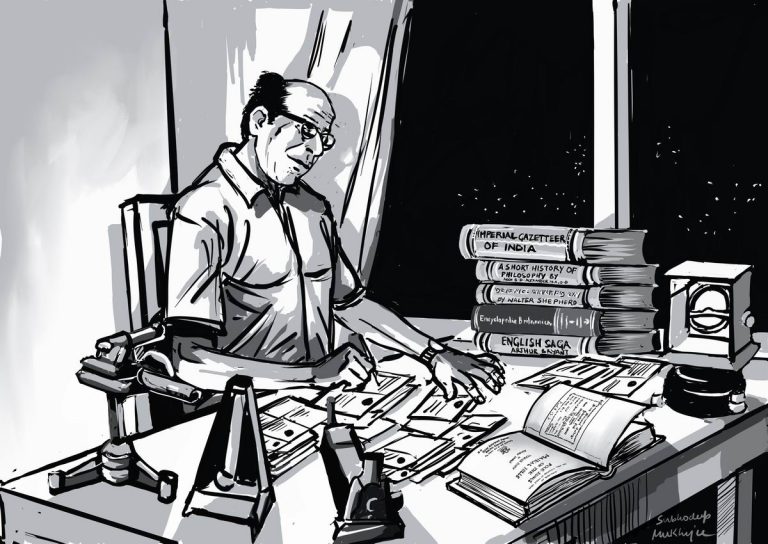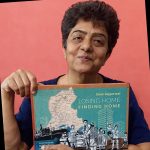
When Partition took place, most of the teachers and students fled the troubles in Sindh and the college remained closed. Professor Kundnani was heartbroken to see his beloved college collapsing, and decided to take it with him to Bombay.
Saaz Aggarwal
Khushiram Motiram Kundnani was my college principal at National College. It was he who built the college in Bombay.
He had been a professor at National College in Hyderabad, in a sprawling campus with our beautiful canal, the Phuleli, flowing past. My father had studied there, and that is where he and Bhai Pratap became friends. Later, Bhai Pratap donated a large sum of money to his college, and the Bhai Dialdas Moolchand Library was built in his father’s name. They also built a hall, which now houses the Physics department of the college, in memory of Bhai Pratap’s brother Naraindas.
He packed some books and laboratory equipment into trunks, took them to the Hyderabad railway station with the help of the college peon Dayaram.
When Partition took place, most of the teachers and students fled the troubles in Sindh and the college remained closed. Professor Kundnani was heartbroken to see his beloved college collapsing, and decided to take it with him to Bombay! He packed some books and laboratory equipment into trunks, took them to the Hyderabad railway station with the help of the college peon Dayaram. Luggage was being searched and when Kundnani was asked what was inside the trunks, he replied proudly, “Treasure!” The armed police leapt on the trunks and opened them – and, seeing books and instruments, snorted in disgust and told him to move along.
It was a difficult journey. When he eventually arrived in Bombay, he lived in a cramped room in a crowded locality with a number of other families who had also fled Sindh. He worked hard to find a place to start the college, and while doing so, he also kept in touch with his colleagues, writing postcards every Sunday, promising them that he was going to build National College in Bombay. “We are all going through a very difficult time,” he wrote. “I know you are struggling to earn enough to feed your family. Whether you are doing this by giving tuitions, or helping in your uncle’s shop, or working with the women of your family to cook and provide meals to others – stay cheerful! Very soon, our National College will start and we will get our classrooms and our students back.”
Kundnani was determined, and he found a piece of land, raised contributions from Bhai Pratap and other wealthy members of the community with the help of barrister Hotchand Advani – Kundnani’s wife Jotu contributed her jewellery to this fund too – and started building. In June 1949, the college started. In Sindh it was called DG National College – Dayaram Gidumal National College, in honour of Dayaram Gidumal Shahani, one of the most prominent and benevolent judges and scholars of Sindh, whose family still lives in Sindh. In Bombay, Principal Kundnani named his college after the same wise man, but used different initials, RD National College – Rishi Dayaram National College.
Though we were living quite far away, my father insisted that I should study at Kundnani’s new college, and for all those years I had to commute. I graduated from there, then earned an MSc in Chemistry and got a job as a Demonstrator in the Chemistry Department there. During those years, I also met my future husband, Bob Savur, in National College! We got married and went to live in the Nilgiris where he was a tea planter.
The illustration above, by Subhodeep Mukherjee, shows Khushiram Kundnani sitting at a table writing postcards to his colleagues who have been displaced and made homeless, like him, by Partition. These are some of the books and laboratory equipment carried by him, which are still in use at National College, Mumbai.
[Excerpted from Losing Home, Finding Home by Saaz Aggarwal]
____________________
 Saaz Aggarwal is an independent researcher, writer and artist based in Pune, India. Her body of writing includes biographies, translations, critical reviews and humor columns. Her books are in university libraries around the world, and much of her research contribution in the field of Sindh studies is easily accessible online. Her 2012 Sindh: Stories from a Vanished Homeland is an acknowledged classic. With an MSc from Mumbai University in 1982, Saaz taught undergraduate Mathematics at Ruparel College, Mumbai, for three years. She was appointed features editor at Times of India, Mumbai, in 1989.
Saaz Aggarwal is an independent researcher, writer and artist based in Pune, India. Her body of writing includes biographies, translations, critical reviews and humor columns. Her books are in university libraries around the world, and much of her research contribution in the field of Sindh studies is easily accessible online. Her 2012 Sindh: Stories from a Vanished Homeland is an acknowledged classic. With an MSc from Mumbai University in 1982, Saaz taught undergraduate Mathematics at Ruparel College, Mumbai, for three years. She was appointed features editor at Times of India, Mumbai, in 1989.
Courtesy: Saaz Aggarwal | Sindh Stories (Posted on Dec 2, 2022)